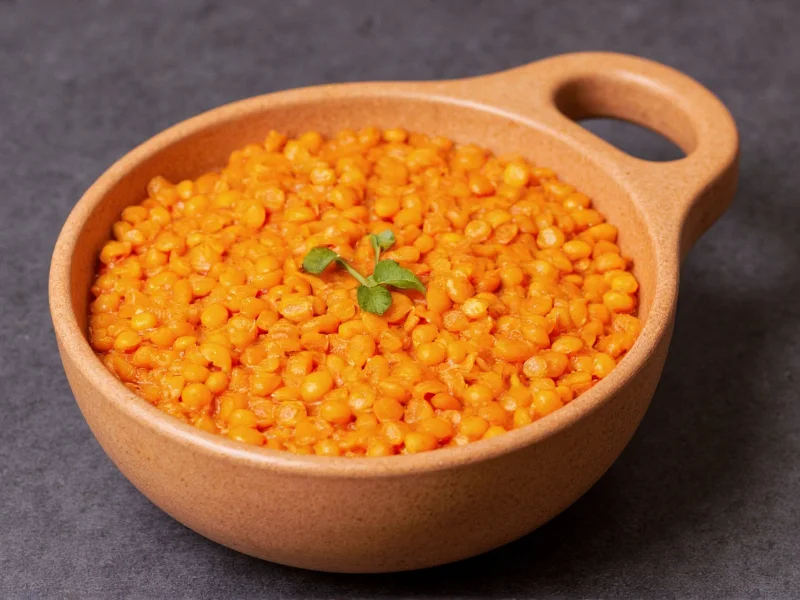When exploring orange lentils, you're discovering one of the most versatile and nutritionally dense legumes available. Unlike many other lentil varieties, orange lentils break down easily during cooking, making them ideal for creating creamy textures without additional thickeners. This unique characteristic has made them a staple in Indian, Middle Eastern, and Mediterranean cuisines for centuries.
Understanding Orange Lentils: Characteristics and Identification
Despite their name, orange lentils actually begin as reddish-orange dried legumes that transform to a golden yellow color when cooked. They're smaller and flatter than green or brown lentils, typically measuring 2-3mm in diameter. The most common variety is masoor dal, which refers to split and skinned red lentils that cook quickly and have a delicate, slightly sweet flavor.
Many shoppers confuse orange lentils vs red lentils, but these are essentially the same product at different processing stages. Whole red lentils maintain their shape better during cooking, while split orange lentils (with the seed coat removed) cook faster and break down more readily. This distinction matters significantly when substituting orange lentils in recipes that require specific textures.
Nutritional Powerhouse: Health Benefits of Orange Lentils
The nutritional benefits of orange lentils make them a valuable addition to any diet. A single cooked cup (198g) provides:
| Nutrient | Amount per Cooked Cup | % Daily Value |
|---|---|---|
| Calories | 230 | 12% |
| Protein | 18g | 36% |
| Fiber | 15g | 54% |
| Folate | 358mcg | 90% |
| Iron | 6.6mg | 37% |
These impressive numbers explain why nutritionists frequently recommend orange lentils for health benefits of orange lentils including improved digestion, stabilized blood sugar levels, and heart health support. The high fiber content promotes satiety, making them excellent for weight management. Their low glycemic index (around 29) means they release energy slowly, preventing blood sugar spikes.
Mastering Orange Lentils Cooking Techniques
One of the most appealing features for home cooks is the orange lentils cooking time—typically just 15-20 minutes without presoaking. This quick preparation makes them perfect for weeknight meals when time matters. Unlike other legumes, orange lentils don't require soaking, though rinsing them thoroughly before cooking removes any dust or debris.
For perfect results when how to cook orange lentils, use a 2:1 water-to-lentil ratio. Bring to a boil, then reduce to a simmer. Stir occasionally to prevent sticking. The lentils are done when tender and have lost their shape, creating that desirable creamy consistency. Adding acidic ingredients like tomatoes too early can prevent softening, so wait until the lentils are nearly cooked before incorporating these elements.
Culinary Applications and Recipe Inspiration
The mild, slightly sweet flavor of orange lentils makes them incredibly versatile. They work beautifully in:
- Dals and curries: The foundation of many Indian dishes like masoor dal
- Soups and stews: They create natural thickness without flour or cream
- Veggie burgers: Their binding quality makes excellent plant-based patties
- Baby food: Their smooth texture after cooking is ideal for infants
- Salads: When cooked al dente for firmer texture
For those exploring best recipes with orange lentils, try a simple red lentil soup with carrots, onions, and cumin, or a creamy coconut lentil curry. They also work well in western dishes like lentil shepherd's pie or as a meat substitute in tacos. Their ability to absorb flavors while maintaining nutritional integrity makes them a chef's secret weapon.
Storage and Selection Guidelines
Knowing where to buy orange lentils and how to store them properly extends their shelf life and maintains quality. Find them in the bulk section of health food stores, international markets (particularly Indian and Middle Eastern grocers), or the legume aisle of most supermarkets.
When selecting, look for uniform color without dark spots or moisture. Store dried lentils in an airtight container in a cool, dark place where they'll keep for 6-12 months. Cooked orange lentils refrigerate well for 3-5 days or freeze for up to 6 months. Never store them in their cooking liquid if planning to use leftovers in dishes requiring distinct lentil texture.
Comparing Lentil Varieties for Optimal Results
Understanding the differences between lentil types helps you choose the right one for your culinary needs. While orange lentils vs red lentils are essentially the same product at different processing stages, they differ significantly from other varieties:
- Green/Brown lentils: Hold shape better, longer cooking time (25-30 minutes), earthier flavor
- French (Puy) lentils: Peppery taste, maintain shape even after long cooking
- Black (Beluga) lentils: Rich flavor, resemble caviar when cooked
Orange lentils' tendency to break down makes them unsuitable for salads where distinct lentil shape matters, but perfect for soups and purees where creaminess is desired. This knowledge proves invaluable when substituting orange lentils in recipes designed for other lentil types.
Addressing Common Orange Lentil Questions
Many home cooks have specific concerns about working with orange lentils. Understanding proper rinsing techniques prevents mushiness, while knowing when to add spices maximizes flavor development. The quick cooking time means they're less forgiving than other lentils—you can't walk away while they cook without risking overcooking.
For those with digestive sensitivities, starting with smaller portions helps your system adjust to the high fiber content. Pairing orange lentils with digestive spices like cumin or ginger can also minimize potential discomfort while enhancing flavor.











 浙公网安备
33010002000092号
浙公网安备
33010002000092号 浙B2-20120091-4
浙B2-20120091-4